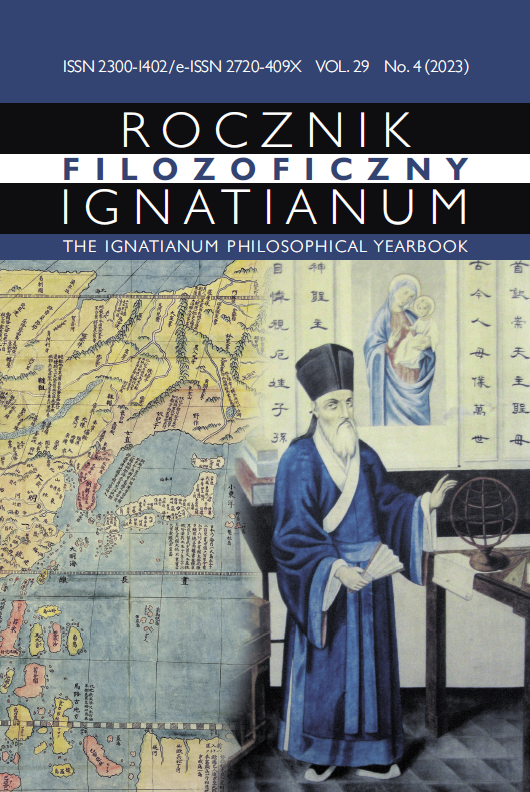The Discovery and Importance of the Stele from Xi’an for the Jesuit Missions in China in XVII Century in the Light of Historiae Sinarum Imperii of Tomasz Szpot Dunin (1644–1713)
Abstract
The article deals with the discovery of a Nestorian stele in Xi’an – the former capital of China – which was erected in 781 and discovered in 1625. The finding quickly attracted the attention of some of the Jesuit missionaries working in China, who not only examined the stele on the site, but also described its content in the reports sent to the Superior General. The discovery from Xi’an was highlighted in the first monographies dedicated to the history of the Jesuit missions in China written, among others, by Álvaro de Semedo, Michael Boym, Athanasius Kircher. The stele was an important evangelization tool, as it well corresponded with traditional Chinese culture, which emphasized the value of historical continuation and conservatism. Thomas Szpot Dunin stresses the threefold significance of the discovery. Firstly, its presence indicated that Christianity was on equal footing with traditional Chinese religions such as Taoism, Buddhism, Confucianism. Secondly, the inscription emphasized the monotheism of the Christian religion, which served well the Jesuits missionaries, who, like Matteo Ricci, tried to convince the Chinese that they had been monotheists in the ancient times. Thirdly, the finding of the monument contributed to missionary success in Shaanxi province itself.
References
ARSI, Jap. Sin.102. ARSI, Jap. Sin. 103.
Michał Boym, Flora Sinensis, fructus floresque humillime porrigens, serenissimo et potentissimo principii, ac Domino, Domino Leopoldo Ignatio, Hungariae Regi Florentissimo, etc. Fructus Saeculo promittenti Augustissimos (Viennae– Austriae: Typis Matthaei Rictij, 1656).
Athanasius Kircher, China monumentis, qua Sacris qua Profanis Nec non variis naturae et artis spectaculis, Aliarumque rerum memorabilium Argumentis illustrata (Amsterdami: Apud Jacobum à Meurs, 1667).
Athanasius Kircher, Prodromus Coptus Sive Aegyptiacus (Romae: Typis S. Cong: de propag: Fide, 1636).
Brill’s Encyclopedia of China, red. Daniel Leese (Leiden: Brill, 2009).
Handbook of Christianity in China. Volume One: 635–1800, red. Nicolas Standaert (Leiden–Boston–Köln: Brill, 2001).
Keevak Michael, The Story of a Stele. China’s Nestorian Monument and its Reception in the West, 1625–1916 (Hong Kong: Hong Kong University Press, 2008).
Latourette Kenneth Scott, A History of the Expansion of Christianity. The Thousand Years of Uncertainty A.D. 500–A.D. 1500, vol. II (New York and London: Harper & Brothers Publishers, 1938).
Miyazaki Ischisada, China’s Examination Hell. The Civil Service Examinations of Imperial China (New Haven–London: Yale University, 1976).
Masson Hervé, Słownik herezji w Kościele katolickim (Katowice: Wydawnictwo „Książnica”, 1993).
Moffett Samuel Hugh, A History of Christianity in Asia. Volume I: Beginnings to 1500 (Maryknoll–New York: Orbis Books, 1998).
Moule Arthur Christopher, Christians in China Before the Year 1550 (New York– Toronto: The Macmillan co., 1930).
New Catholic Encyclopedia, t. 3 (New York: McGraw–Hill Book Company, 1967).
Nguyen Duc Ha, Polscy misjonarze na Dalekim Wschodzie w XVII–XVIII wieku (Warszawa: Wydawnictwo Neriton, 2006).
Nicolini–Zani Matteo, The Interpretation of Tang Christianity in the Late Ming China Mission. Manuel Dias Jr.’s Correct Explanation of the Tang “Stele Eulogy on the Luminous Teaching” (1644) (Leiden–Boston: Brill, 2023).
Ostrogorski Georgij, Dzieje Bizancjum (Warszawa: PWN, 1967).
Pelliot Paul, L’inscription nestorienne de Si-ngan-fou (Kyoto–Paris: Italian School of East Asian Studies et Collège de France, 1996).
Rodzinski Witold, A History of China, t. I (Oxford: Pergamon Press, 1979). Saeki Yoshiro, The Nestorian Monument in China (New York–Toronto: The Macmillan co., 1916).
Barat Kahar, “Aluoben, A Nestorian Missionary in 7th Century China”, Journal of Asian History 36/2 (2002): 184–198.
Malinowski Gościwit, „Chińczycy w Starym Testamencie – Cornelius a Lapide SJ i jego egzegeza wersetu z Księgi Izajasza (49,12)”, Rocznik Filozoficzny Ignatianum 27/1 (2021): 19–42.
Danieluk Robert, „Konfesjonał i pióro: Tomasz Ignacy Szpot Dunin, polski historiograf jezuickiej misji w Chinach”, w: Iesuitae in Polonia – Poloni Iesuitae. Piśmiennictwo łacińskie czasów nowożytnych, red. Jarosław Nowaszczuk (Szczecin: Volumina.pl, 2017), 75–108.
Shu Jian, „The Role of China in the Dissemination of Christianity to the Korean Peninsula in the Early Modern China”, w: Beyond Indigenization. Christianity and Chinese History in a Global Context, red. Tao Feiya, tłum. Max
L. Bohenkamp (Leiden–Boston: Brill, 2022), 406–423.
Stang Charles M., “The (Jingjiao) Monument and its Theology of the Cross”, w: Syriac in its Multi–cultural Context, red. Herman Teule, Elif Keser-Kayaalp, Kutlu Akalin, Nesim Doru, M. Sait Toprak (Leuven: Peeters, 2017), 107–118.
Zhu Donghua, „The Chronology of the Tang Dynasty Jingjiao Nestorian Theologian Jingjing’s Writings and Translations in Relation to His Thought”, w: Beyond Indigenization. Christianity and Chinese History in a Global Context, red. Tao Feiya, tłum. Max L. Bohenkamp (Leiden–Boston: Brill, 2022), 25–45.
Robert Menzies, The Future of the Church in China: Why China’s House Churches will Prevail, https://www.yumpu.com/en/document/read/62177887/ australia-november-2018 (dostęp: 02.12.2023).
Copyright (c) 2023 Ignatianum University in Cracow

This work is licensed under a Creative Commons Attribution-NoDerivatives 4.0 International License.
The Yearbook only accepts materials for publication that are free of all conflicts of interest, and that in no way involve conflicts over authorship, copyright, etc. The Editors will take action against any cases of plagiarizing, ghostwriting1, guest/honorary authorship2, etc. Where co-authored work is concerned, the Author listed first is expected to take responsibility for the submission, and is required to make clear the contributions of all of the Co-Authors involved. In the event of the publication owing its existence to funding dedicated to this purpose, this fact should be made clear: e.g. in any note of thanks/acknowledgement, or in a footnote, etc. Explicit notification should be given of any form of reprinting, with the appropriate evidence of permission to publish being furnished as required. Any impropriety on the part of Authors/Reviewers risks exposing them to appropriate responses from the relevant institutions.
______
1 This term refers to instances of a person who has made an essential contribution being omitted from the list of authors, or from notes conveying gratitude and/or acknowledgement.
2 This occurs when a person who has made either an insignificant contribution or no contribution at all nevertheless appears on the list of authors.





